
Learn Bridge Very Slowly
Apprenez Le Bridge Pas a Pas
Apprenez Le Bridge Pas a Pas


1) THE BASIC RULES
A)Bridge is a card game
A pack of 52 cards is used(no jokers).
This is what the 52 cards look like, when spread out, face up:
They are divided into four “suits”:
ªSpades(S)
©Hearts(H)
¨Diamonds(D)
§Clubs(C)
As you can see, there are thirteen cards per suit, and their ranking in each suit is, from best to worst: Ace, King, Queen, Jack, 10, 9, 8, 7, 6, 5, 4, 3, 2. The Ace beats the King, which beats the Queen, which beats the Jack, which beats the 10, etc…
The Ace of Spades is represented by the symbol ªA. Likewise the 51 other cards are represented by symbols. For example: ªK, ªQ, etc… , ©A, ©K, etc…, ¨6, ¨2, §J, §8, etc…
When faced down, all the cards look like this:
A)Bridge is a card game
A pack of 52 cards is used(no jokers).
This is what the 52 cards look like, when spread out, face up:
They are divided into four “suits”:
ªSpades(S)
©Hearts(H)
¨Diamonds(D)
§Clubs(C)
As you can see, there are thirteen cards per suit, and their ranking in each suit is, from best to worst: Ace, King, Queen, Jack, 10, 9, 8, 7, 6, 5, 4, 3, 2. The Ace beats the King, which beats the Queen, which beats the Jack, which beats the 10, etc…
The Ace of Spades is represented by the symbol ªA. Likewise the 51 other cards are represented by symbols. For example: ªK, ªQ, etc… , ©A, ©K, etc…, ¨6, ¨2, §J, §8, etc…
When faced down, all the cards look like this:
C)Dealing and sorting the cards
At the beginning of a game, the cards are thoroughly shuffled, and one of the four players is designated to deal the cards. That player is called the “Dealer”.
The Dealer deals all 52 cards, one by one, face down, clockwise, the first card being given to the player on Dealer’s left:
Etc………
The last card dealt should then be for the Dealer.
In this way, each player gets thirteen cards, picks them up and looks at them. These thirteen cards are called a “hand” of cards.
Each player sorts his hand into suits, with the cards in each suit sorted in descending order from the left to the right. For example a hand could look like this:
It is easy to hold it:
…but always close to the chest, to make sure the other three players cannot see the face of the cards.
At the beginning of a game, the cards are thoroughly shuffled, and one of the four players is designated to deal the cards. That player is called the “Dealer”.
The Dealer deals all 52 cards, one by one, face down, clockwise, the first card being given to the player on Dealer’s left:
Etc………
The last card dealt should then be for the Dealer.
In this way, each player gets thirteen cards, picks them up and looks at them. These thirteen cards are called a “hand” of cards.
Each player sorts his hand into suits, with the cards in each suit sorted in descending order from the left to the right. For example a hand could look like this:
It is easy to hold it:
…but always close to the chest, to make sure the other three players cannot see the face of the cards.

Jacques Lumbroso




















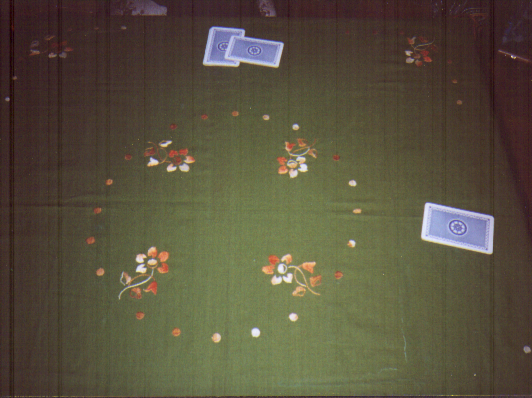




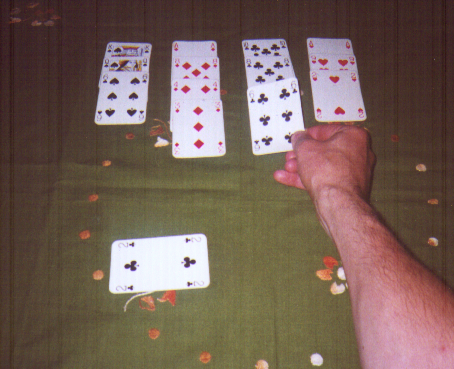

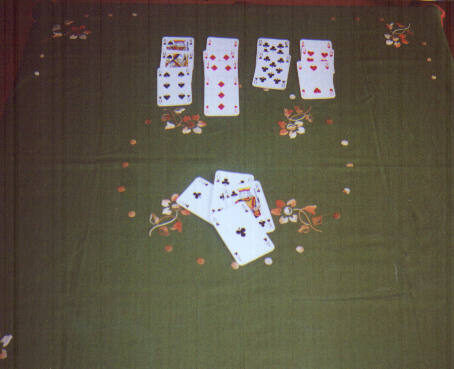
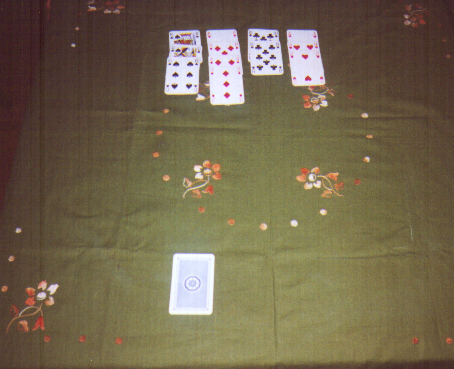
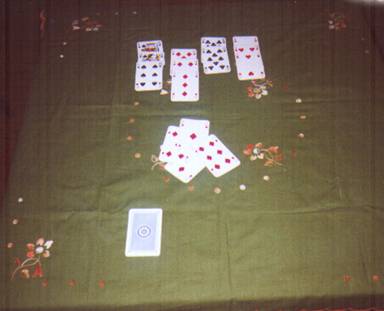
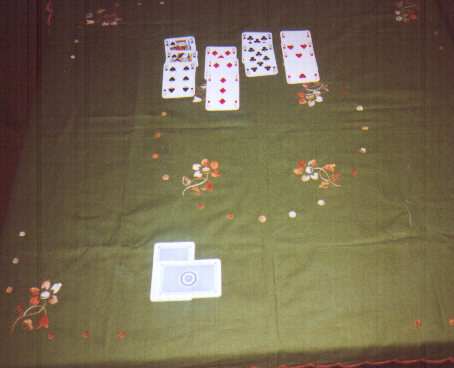

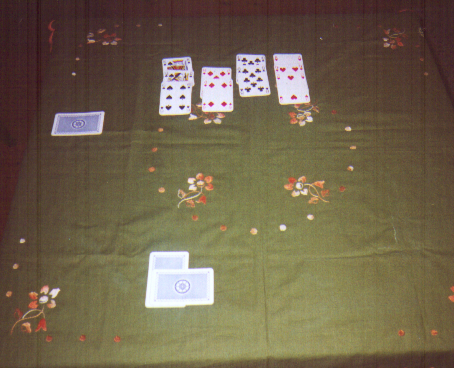

B)The players
Bridge is played by four people, sitting around a table:
They are placed, for convenience, in the North, South, East and West positions. They play two against two. Players sitting opposite each other are partners.
North and South always play against East and West.
These four positions do not have to be geographically correct. Just pick a direction, call it North, and sit everybody accordingly:
From now on, the four players will be called “North”, “South”, “East” and “West”.
Bridge is played by four people, sitting around a table:
They are placed, for convenience, in the North, South, East and West positions. They play two against two. Players sitting opposite each other are partners.
North and South always play against East and West.
These four positions do not have to be geographically correct. Just pick a direction, call it North, and sit everybody accordingly:
From now on, the four players will be called “North”, “South”, “East” and “West”.
D)Winning “tricks”
Important rule: when someone plays a card of a particular suit, each of the three other players must play a card of the same suit. It is called “following suit”. The play of the cards must be in a clockwise manner.
For example, West plays the ª5:
Important rule: when someone plays a card of a particular suit, each of the three other players must play a card of the same suit. It is called “following suit”. The play of the cards must be in a clockwise manner.
For example, West plays the ª5:
Then North plays the ªK, East the ªA, and South the ª4:
These four cards are called a “trick”.
Whoever plays the highest card “wins” the trick. In our example East won the trick as he played the ªA, the highest of the four cards. He picks it up, making a neat pile of the four cards, and places it face down in front of him:
Whoever plays the highest card “wins” the trick. In our example East won the trick as he played the ªA, the highest of the four cards. He picks it up, making a neat pile of the four cards, and places it face down in front of him:
When West played the ª5, he was said to have “led” that card.
The three other players had then to follow suit: to play a spade each. If a player doesn’t have any card of a suit led, he has the freedom to play any card of any of the three other suits, but cannot win the trick, as it can only be won by a card of the suit led. In our example, if East had no spade, he could play anything else, but could not beat North’s ªK, even if he played an ace of another suit.
The winner of a trick always begins the play for the next trick, and has the freedom to play any card from his hand.
In our example, East begins the play for the second trick with the ¨2.
Then, as always in a clockwise manner, and following suit, South plays the ¨6, West the ¨J, and North the ¨Q. North is the winner of the second trick. He picks it up and places it face down in front of him:
The three other players had then to follow suit: to play a spade each. If a player doesn’t have any card of a suit led, he has the freedom to play any card of any of the three other suits, but cannot win the trick, as it can only be won by a card of the suit led. In our example, if East had no spade, he could play anything else, but could not beat North’s ªK, even if he played an ace of another suit.
The winner of a trick always begins the play for the next trick, and has the freedom to play any card from his hand.
In our example, East begins the play for the second trick with the ¨2.
Then, as always in a clockwise manner, and following suit, South plays the ¨6, West the ¨J, and North the ¨Q. North is the winner of the second trick. He picks it up and places it face down in front of him:
Then North begins the play for the third trick by leading the ©6. East plays the ©Q, South the ©A, and finally West the ©2. South, the winner of this third trick, picks it up and puts it down with North’s trick, as two partners always accumulate their tricks together:
The game continues like this until all thirteen tricks have been won. For example it could be eight tricks for North-South and five for East-West:
Or it could be ten for East-West and three for North-South, etc…
E)“Bidding” for tricks and for a “trump suit”
The major difficulty of the game, and also one of its attractions, is that, before the cards are played, at least one of the players must guess the minimum number of tricks that he and his partner intend to make, on condition that this number is at least seven (the majority of the thirteen tricks).
If a player thinks that less than seven tricks can be made by his side(himself and his partner), then he can say “PASS”.
The purpose of gambling for a number of tricks (instead of saying PASS), is to score points. Generally, the more tricks two partners gamble for, the higher their score, provided they make at least the number of tricks mentioned. On the other hand, if the two partners make fewer tricks than gambled for, they get no score, and it is the other two players that get a score.
As well as gambling for a number of tricks, a player can choose one of the four suits as a “trump suit”.
What is a trump suit? Any card of the trump suit can beat any card of the other three suits, if one cannot follow suit.
In our above example, if diamonds were trumps for that particular game, and if South had no spade to play, then South could play any diamond and win the trick:
The major difficulty of the game, and also one of its attractions, is that, before the cards are played, at least one of the players must guess the minimum number of tricks that he and his partner intend to make, on condition that this number is at least seven (the majority of the thirteen tricks).
If a player thinks that less than seven tricks can be made by his side(himself and his partner), then he can say “PASS”.
The purpose of gambling for a number of tricks (instead of saying PASS), is to score points. Generally, the more tricks two partners gamble for, the higher their score, provided they make at least the number of tricks mentioned. On the other hand, if the two partners make fewer tricks than gambled for, they get no score, and it is the other two players that get a score.
As well as gambling for a number of tricks, a player can choose one of the four suits as a “trump suit”.
What is a trump suit? Any card of the trump suit can beat any card of the other three suits, if one cannot follow suit.
In our above example, if diamonds were trumps for that particular game, and if South had no spade to play, then South could play any diamond and win the trick:
Note that following suit is compulsory: South could only play a trump card(here a diamond) if he had no spade left.
Note also that if a player cannot follow suit, playing a trump card is not compulsory. Any other card will do, but of course only a trump will win the trick.
We saw previously that the winner of a trick is the player who played the highest card of the suit led, but now that the notion of trump has been introduced, the definitive rule is: a trick is won by:
.the highest card of the suit led if no trump is played in the trick.
.a trump.
.the highest trump, if at least two trumps are played in a trick.
Note also that if a player cannot follow suit, playing a trump card is not compulsory. Any other card will do, but of course only a trump will win the trick.
We saw previously that the winner of a trick is the player who played the highest card of the suit led, but now that the notion of trump has been introduced, the definitive rule is: a trick is won by:
.the highest card of the suit led if no trump is played in the trick.
.a trump.
.the highest trump, if at least two trumps are played in a trick.
As we just said, as well as gambling for a number of tricks a player can choose one of the four suits as a trump suit. For example one of the four players can say something like “My partner and I will make at least eight tricks, and I choose clubs as trumps”. It is called a “bid”.
Which of the four players can make a bid? In fact they all can, one at a time, taking turns.
This is how it always goes:
.Dealer is the first player who can pass or make a bid.
.then the “bidding” goes clockwise, to Dealer’s left-hand opponent, who can pass, or bid a higher number of tricks and choose one of the four suits as trump.
.then the bidding goes clockwise again, to every player in turn (Dealer’s partner, then Dealer’s right-hand opponent, then Dealer again, etc…), with the choice of either a pass, or an increase in the number of tricks, with as usual the choice of one of the four suits as trump.
The bidding is over when three passes in succession have followed any bid. So in fact any player could bid a number of times, as long as three passes don’t come in succession. It is nevertheless important to note that if the first three players have passed in the beginning, the fourth may still bid.
When the bidding is over, the play of the cards starts.
Let’s see an example of bidding, with East the Dealer:
.East says pass.
.South bids for seven tricks, with clubs as trumps.
.West bids for nine tricks, with spades as trumps.
.North says pass.
.East bids for ten tricks, with diamonds as trumps.
.South bids for twelve tricks, with clubs as trumps.
.West says pass.
.North says pass.
.East says pass.
That’s it. Three passes in succession have followed a bid, so the bidding is over. Note that a player is allowed to bid when his turn comes again, even if he had previously passed(like East in our example, when he bids for ten tricks, with diamonds as trumps, after passing originally).
Which of the four players can make a bid? In fact they all can, one at a time, taking turns.
This is how it always goes:
.Dealer is the first player who can pass or make a bid.
.then the “bidding” goes clockwise, to Dealer’s left-hand opponent, who can pass, or bid a higher number of tricks and choose one of the four suits as trump.
.then the bidding goes clockwise again, to every player in turn (Dealer’s partner, then Dealer’s right-hand opponent, then Dealer again, etc…), with the choice of either a pass, or an increase in the number of tricks, with as usual the choice of one of the four suits as trump.
The bidding is over when three passes in succession have followed any bid. So in fact any player could bid a number of times, as long as three passes don’t come in succession. It is nevertheless important to note that if the first three players have passed in the beginning, the fourth may still bid.
When the bidding is over, the play of the cards starts.
Let’s see an example of bidding, with East the Dealer:
.East says pass.
.South bids for seven tricks, with clubs as trumps.
.West bids for nine tricks, with spades as trumps.
.North says pass.
.East bids for ten tricks, with diamonds as trumps.
.South bids for twelve tricks, with clubs as trumps.
.West says pass.
.North says pass.
.East says pass.
That’s it. Three passes in succession have followed a bid, so the bidding is over. Note that a player is allowed to bid when his turn comes again, even if he had previously passed(like East in our example, when he bids for ten tricks, with diamonds as trumps, after passing originally).
The last bid is called the “contract”. It states the minimum number of tricks two partners want to make, and which suit has finally been chosen as trump. In our example the last bid was by South (the other three passed afterwards), so the contract is twelve tricks, and clubs are trumps for this particular game. North and South must make at least twelve tricks to get a score.
In the pair(the two partners) that bid the contract, we call “Declarer” the player who was the first to bid with the trump suit that is the suit of the contract, and the other one is called “Dummy”. In our example, South was the first to bid with clubs(the contract suit) as trumps, so South is Declarer and North is Dummy. If North had been the first to bid with clubs as trumps, in a different sequence of bidding, with South still bidding for twelve tricks in the end, with clubs as trumps, then North would become Declarer and South Dummy.
The distinction between Declarer and Dummy is going to become important when the play of the cards starts.
Note: In a game of bridge, bidding for tricks and a trump suit comes before the play of the cards(winning tricks), but it was necessary to discuss paragraph D(“Winning tricks”) first, just to explain what tricks are.
In the pair(the two partners) that bid the contract, we call “Declarer” the player who was the first to bid with the trump suit that is the suit of the contract, and the other one is called “Dummy”. In our example, South was the first to bid with clubs(the contract suit) as trumps, so South is Declarer and North is Dummy. If North had been the first to bid with clubs as trumps, in a different sequence of bidding, with South still bidding for twelve tricks in the end, with clubs as trumps, then North would become Declarer and South Dummy.
The distinction between Declarer and Dummy is going to become important when the play of the cards starts.
Note: In a game of bridge, bidding for tricks and a trump suit comes before the play of the cards(winning tricks), but it was necessary to discuss paragraph D(“Winning tricks”) first, just to explain what tricks are.
F)The play of the cards
The player sitting on Declarer’s left always plays the first card. That first card is called the “opening lead”.
In our above example, where South is Declarer, West plays the opening lead, which could be the §2:
The player sitting on Declarer’s left always plays the first card. That first card is called the “opening lead”.
In our above example, where South is Declarer, West plays the opening lead, which could be the §2:
Then something unusual happens: Dummy spreads all his cards face up on the table, sorted into suits, and facing lengthwise towards Declarer. In this way, everybody can actually see Dummy’s cards during the play.
It could look like this:
It could look like this:
So, for this particular game, everybody can see North’s cards:
ªKQ6 ¨A843 §1086 ©A92
The play of the cards always goes clockwise, so after West’s opening lead, it is Dummy’s turn to play a card. But Dummy does not play any cards himself. Declarer is responsible for playing Dummy’s cards as well as his own. So for example Declarer picks the §6 from Dummy’s hand and plays it:
ªKQ6 ¨A843 §1086 ©A92
The play of the cards always goes clockwise, so after West’s opening lead, it is Dummy’s turn to play a card. But Dummy does not play any cards himself. Declarer is responsible for playing Dummy’s cards as well as his own. So for example Declarer picks the §6 from Dummy’s hand and plays it:
Then East plays the §K, and South the §A:
So the first trick is for North-South:
Declarer(here South) keeps his pair’s winning tricks.
South, winner of the first trick, plays next: the ¨2.Then West the ¨5, then Declarer plays the ¨A from Dummy’s hand(North), and East the ¨6:
South, winner of the first trick, plays next: the ¨2.Then West the ¨5, then Declarer plays the ¨A from Dummy’s hand(North), and East the ¨6:
North won the trick with the ¨A, so the second trick is also for North-South:
North plays next: the ¨3(chosen by Declarer).Then East the ¨10, South the ¨J, and West the ¨K:
So the third trick is for East-West:
Here West keeps his pair’s winning tricks, but it could also be East; it is not important who does.
The play continues, and in the end it could look like this:
The play continues, and in the end it could look like this:
where North-South made eight tricks and East-West five.
G)When the play of the cards is over, the two pairs count their tricks. Declarer and Dummy count them to see if they have made at least the number for which they gambled. If that is the case, they score points. If not, they score nothing, and it is the other two players that score points.
The scoring system will be explained in the next few pages.
Note: there is always a Dummy for each game. Dummy never decides which of his cards to play; Declarer always does.
For every new deal, the cards are shuffled and the right of being Dealer moves clockwise to the next player.
Summary
In chronological order, this is what happens at a game of bridge:
.the cards are dealt and sorted
.the players bid for tricks and a trump suit
.the cards are played
.the score is written down(see later)
Now why don’t you make three phone calls to friends, invite them for tea and biscuits, and explain to them all the above. I can guarantee you that the pack of cards will come out of the drawer and you will have a wonderful time playing your first bridge session. There is a lot more to learn, but so far you have enough to enjoy yourselves.
The scoring system will be explained in the next few pages.
Note: there is always a Dummy for each game. Dummy never decides which of his cards to play; Declarer always does.
For every new deal, the cards are shuffled and the right of being Dealer moves clockwise to the next player.
Summary
In chronological order, this is what happens at a game of bridge:
.the cards are dealt and sorted
.the players bid for tricks and a trump suit
.the cards are played
.the score is written down(see later)
Now why don’t you make three phone calls to friends, invite them for tea and biscuits, and explain to them all the above. I can guarantee you that the pack of cards will come out of the drawer and you will have a wonderful time playing your first bridge session. There is a lot more to learn, but so far you have enough to enjoy yourselves.





